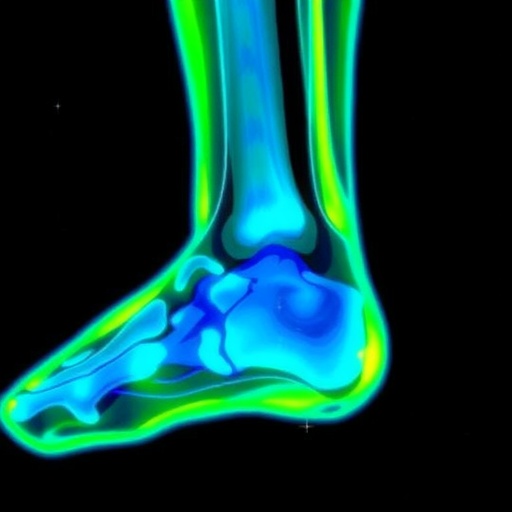In recent years, the pursuit of advanced medical technologies for assessing muscle health has gained momentum, particularly among the geriatric population. As the demographic of aging individuals continues to grow, there is an increasing urgency to devise strategies that can effectively evaluate and maintain muscle integrity in older adults. A groundbreaking study published in European Geriatric Medicine sheds light on the application of shear-wave elastography as a tool for muscle assessment in geriatric outpatients. This innovative imaging technique has the potential to transform how clinicians evaluate muscle stiffness and quality, thus directing preventative strategies toward falls—a prevalent concern among elderly patients.
Shear-wave elastography is a non-invasive imaging modality that measures tissue stiffness by utilizing sound waves. When a shear wave is generated in the tissue, it travels at a speed that is influenced by the elastic properties of that tissue. This technique enables clinicians to obtain quantitative data regarding muscle elasticity and stiffness, parameters that are crucial to assessing muscle health. In the context of elderly patients, where muscle mass tends to decline due to aging—a condition known as sarcopenia—assessing muscle quality becomes vital in addressing the increased risk of falls.
The study authored by Remuss et al. involved a detailed investigation into the efficacy of shear-wave elastography in a cohort of geriatric outpatients who are at increased risk of falling. The researchers aimed to evaluate whether this imaging technique could provide reliable metrics for assessing muscle health and ultimately aid in formulating targeted treatment plans. By measuring muscle stiffness, clinicians may gain insights into the underlying conditions that affect mobility and balance, rendering this method an essential addition to geriatric assessment protocols.
In the population studied, the team observed that lower muscle elasticity signals a higher risk of falls, as reduced elasticity is often correlated with reduced muscle strength and function. This correlation emphasizes the importance of utilizing quantitative methods to glean information that traditional assessment tools may overlook. Through the application of shear-wave elastography, health professionals can strategically allocate resources toward interventions designed to enhance muscle health, improving overall outcomes for elderly patients.
Moreover, the implications of this research extend beyond immediate clinical applications. As the population ages globally, health systems face unprecedented challenges in managing the complexities of geriatric care. By incorporating advanced imaging modalities such as shear-wave elastography into standard practice, healthcare providers can foster a proactive approach to aging-related complications, decreasing the burden of falls and their associated morbidity.
The study’s findings underscore the potential for shear-wave elastography to serve as a complementary tool to existing assessment methods. Traditional techniques may include manual assessments and questionnaires that evaluate strength, balance, and mobility. However, these methods can be subjective and may not capture subtle variations in muscle quality effectively. The introduction of an objective, quantifiable approach through elastography could pave the way for enhanced precision in diagnosing age-related muscular conditions.
As the research progresses, additional studies will be necessary to establish standard protocols for the implementation of shear-wave elastography in diverse clinical settings. Factors such as operator experience, patient positioning, and equipment calibration will all play a crucial role in ensuring the reproducibility and reliability of measurements. Ultimately, developing clear guidelines will facilitate the integration of this technology into routine geriatric assessments, fostering wider adoption in clinical practice.
Implementing shear-wave elastography can also contribute to patient education regarding muscle health. By utilizing visual data and objective findings, healthcare providers can better communicate risks and engage patients in discussions about their health. Informing patients about the importance of muscle maintenance can lead to better adherence to prescribed exercise regimens and lifestyle modifications, further reducing the risk of falls.
Innovations like shear-wave elastography have the potential to champion a paradigm shift in geriatrics—transitioning from reactive care to proactive strategies that empower patients. The ongoing commitment to enhancing diagnostic technology signifies a remarkable evolution in how we approach aging. By equipping healthcare providers with better tools to assess risk factors, we can create a healthier aging population, minimizing complications and maximizing quality of life.
The researchers acknowledge that despite the promising results, further validation is needed through larger clinical trials to scrutinize the long-term effectiveness of shear-wave elastography on patient outcomes. Multi-center studies can help address variability in results due to differences in populations and settings. Additionally, collaborations between researchers, geriatricians, and physiotherapists could foster holistic approaches to fall prevention and muscle health promotion.
As we embrace the future of geriatric care, the integration of advanced imaging technologies like shear-wave elastography highlights the importance of interdisciplinary cooperation in addressing the challenges posed by an aging population. By continuing to advance our understanding of muscle health through innovative techniques, the healthcare community can ensure that older adults receive the attention and care they deserve, ultimately leading to healthier, safer aging experiences.
In conclusion, the innovation of shear-wave elastography represents a promising frontier in the assessment of muscle health among elderly individuals at risk of falling. As this research continues to unfold, it reaffirms the commitment to enhancing geriatric care through evidence-based practices and cutting-edge technology. The path forward is clear: as we refine tools for muscle assessment, we enhance the capacity to combat the challenges of aging, ensuring a future where the elderly can maintain their independence and live fulfilling lives.
By participating in this revolution in geriatrics, we are not just changing the way we assess muscle health; we are changing lives, providing older adults with the means to maintain their mobility and independence far into their later years.
Subject of Research: Muscle assessment using shear-wave elastography in geriatric outpatients.
Article Title: Shear-wave elastography for muscle assessment in geriatric outpatients at increased risk of falling.
Article References:
Remuss, C., Krone, J.O., Giger, AK.W. et al. Shear-wave elastography for muscle assessment in geriatric outpatients at increased risk of falling.
Eur Geriatr Med (2025). https://doi.org/10.1007/s41999-025-01333-6
Image Credits: AI Generated
DOI: https://doi.org/10.1007/s41999-025-01333-6
Keywords: Shear-wave elastography, muscle assessment, geriatric care, falls risk, muscle stiffness, aging population.




